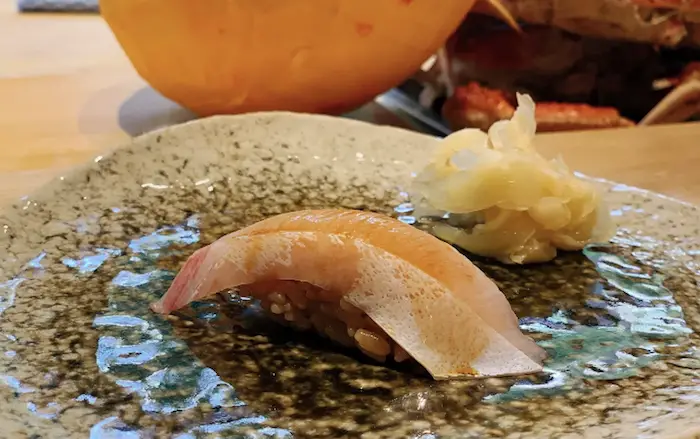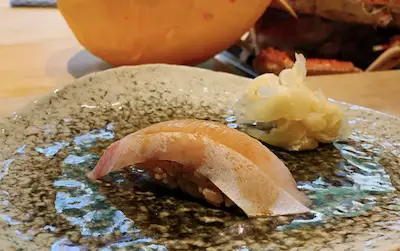We are reader supported. When you purchase through links on our site, we may earn an affiliate commission. Also, as an Amazon affiliate, we earn from qualifying purchases.

There are so many options when it comes to sushi and one that I hear of regularly (that some people might not know of) is yellowtail sushi. I did some extra research on this one to be sure you have as much information as possible. With that in mind, let’s dive right in and explore exactly what yellowtail sushi is.
What is yellow tail sushi? When referring to yellowtail sushi the fish used is called yellowtail amberjack or Japanese amberjack. Other names for the yellowtail are Hamachi (yellowtail in Japanese), buri, racing tuna and king amberjack. Yellowtail is an excellent choice for raw eating which makes it the perfect fish for sushi.
There are well over 50 different species of fish that have yellow tail in their name so it can be confusing deciding on exactly which one you want for your sushi. To name a few, there are yellowtail flounder, yellowtail snapper, cape yellow tail, longfin yellowtail, yellowtail bass and so on. In this article, we will focus on the yellowtail amberjack because this is a great raw fish for fish.
Contents
What Type of Yellowtail Fish is used for Sushi?
When you hear the name yellowtail you might think right away of Tuna. You wouldn’t be that far off as the yellowtail amberjack is related to the yellowtail tuna fished of the coasts of the United States. As well, the yellowfin tuna’s tail fin looks quite similar to the amberjack’s tail fin.
So, the yellowtail amberjack is a species of jack fish.
Where Does Yellowtail Sushi Come from?
The fish itself originated off the coast of Japan. It is now farmed in very large cages in the ocean but inland in Japan. Some yellowtail amberjack can be fished wild off the coast of Japan and the west coast of the United States.
Fish farms containing Hamachi/yellowtail amberjack can also be found in Mexico and Australia.

Something to consider when purchasing yellowtail amberjack for sushi is that farmed fish is less likely to have parasites VS fish caught in the wild. We have discussed this in a previous article.
Is Yellowtail Sushi Raw?
Most of the time your yellowtail sushi will be raw. Some venues might offer the fish slightly cooked, depending on what the market demands. If you are eating sushi that has the yellowtail amberjack in it, then go for the raw fish. Raw amberjack is so delicious that you would almost think the fish was specifically created just for sushi.
Is Yellowtail a Fatty Fish?
This fish is fatty but not as fatty as some other types of sushi fish. The benefit of eating Hamachi is that the fish does contain quite a bit of healthy omega 3 oils. So it is not only delicious but has health benefits for humans.
In addition to Hamachi being fatty, we can look at some other nutritional information such as protein and calories per 3.5 ounce serving. Protein is approximately 23 grams and there is approximately 146 calories per 3.5 ounce serving. This makes it easy if you are counting calories or trying to reach a specific amount of protein per day.
What does Yellowtail Sushi Taste Like?
Yellowtail amberjack is a light-tasting fish. It almost has a buttery flavor to it and mildly sweet. If the fish is seared it will not have as much of an oily taste, unless an oil is used to sear the fish in. When finishing your sushi you might notice a tangy taste coming from the fish.
You might find the darker parts of the fish have a stronger fishy taste than other lighter parts of the fish. If you don’t enjoy fishy tastes then ask to have the lighter parts of the fish in your sushi.
Hamachi is continuously being labelled one the best tasting sushi fish to try.
Remember that if you are having a sushi roll with sticky rice and other ingredients, the flavor of everything mixed together will be an explosion of deliciousness in your mouth.
That being said, if you have yellowtail nigiri which is the raw fish laid over a small ball of sticky rice, the taste will be just as wonderful. This is because of the flavors described above.
Hamachi/yellowtail is the perfect choice for sashimi. Because of its oily buttery taste (when adding wasabi and possibly soy sauce) you are going to really enjoy this fish sashimi style. It must be sushi grade Hamachi, however. Most sushi grade yellowtails are farm raised where the fish can grow to full size in a stress-free environment.
What is a Yellowtail Roll?
A yellowtail roll is what most North Americans are familiar with or have tried. Ingredients for an easy-to-make yellowtail sushi roll include:
- Sushi rice (sticky rice)
- Strips of yellowtail
- Scallion finely chopped (green onion)
- Nori (seaweed sheet)
- Wasabi
- Ginger
- Soy sauce
It might not seem like much for ingredients but trust me on this one, you will be addicted when you try this sushi roll. It will be juicy and full of flavor with a punch of heat from the wasabi. It doesn’t get much better than that.
Related Questions
Is yellowtail the same as tuna?
This question was answered above, however, it warrants ensuring you understand the difference.
Hamachi/Yellowtail:
- Sleek body which looks very similar to a tuna.
- Has a yellow stripe across its body as well as a yellow tail.
- Average grown weight is between 10 and 20 lbs.
- Flesh is light and sometimes has a dark color running along the edge of the fillet.
- Is confused with yellow fin tuna because of name.
- Is related to tuna.
- Mostly found in the Pacific Ocean.
Yellowfin Tuna:
- Yellowfin tuna can grow as big as 400 to 500lbs.
- Grow to a length of 6’.
- They have a torpedo shaped body.
- Coloring is metallic blue back, silver belly, yellowish sides as well as bright yellow dorsal and tail fins.
- Can be found in the Atlantic, Pacific and the Indian oceans. They are currently being overfished in the Indian oceans.
Even though there would be no mistaking this fish when full grown, yellowfin tuna look very similar to yellowtail when young.
Is yellowtail better than tuna?
This would be a matter of preference and what you are using it for. I would say based on the information already provided that yellowtail is a much better choice for sashimi, nigiri and sushi rolls than tuna yet again this depends on your taste buds.
Tuna is a fine option for sushi, however, it can be a bit drier to the pallet compared to the yellowtail. If seared and added to a sashimi dish tuna then it is a fine choice.
You will have to try both side-by-side and see what you think is the best option.
Is Hamachi the same as Yellowtail?
We have covered this as well. The clear-cut answer, however, is yes. Hamachi is the Japanese word for Yellowtail.
What color is yellowtail sushi?
The actual yellowtail fish itself is light-colored pink as it is higher in fat. There is a dark line on the edge of the flesh/fillet. When cooked, the fish firms up and becomes more of a white color.
What is the best way to cook Yellowtail?
I would prefer you didn’t cook this fish. I feel once you try it raw you will feel the same. However, if you must, the best ways would be to lightly sear, sautéed, grill and/or broil it. The cooking method should depend on what dish the fish will be used for.
Is yellowtail sushi safe during pregnancy?
You should really consult with a doctor before eating anything raw. I did do some research and found on an American pregnancy site that eating raw Hamachi is not recommended if you are pregnant. There could be mercury in the fish that is not healthy for you. If you follow this link you will also find other fish that you should stay away from. I cannot stress enough that checking with your doctor before eating anything raw is extremely important.
Conclusion
There you have it. After reading this article, you should have a much better understanding on what yellowtail sushi is (and what it is not). You know that there is a difference between yellowtail fish and yellowfin tuna. Now, when you order from your favorite sushi bar, you will be confident knowing exactly what it is you will be eating. You know that yellowtail is much better served raw and that it is delicious. So, off you go to indulge in that yellowtail sushi.

